Hermeneutyka sztuki średniowiecznej: własna lub zapożyczona? Próba zastosowania procedur hermeneutyki filozoficznej do badań nad sztuką
The Hermeneutics of Medieval Art: Own or Loaned? An Attempt to Apply the Procedures of Philosophical Hermeneutics in Art Research
Author(s): Dariusz TaborSubject(s): Fine Arts / Performing Arts, History of Art
Published by: Towarzystwo Naukowe KUL & Katolicki Uniwersytet Lubelski Jana Pawła II
Keywords: hermeneutics; hermeneutics of art history; hermeneutic circle; medieval art; hermeneutic horizon
Summary/Abstract: Max Imdahl’s hermeneutics distinguishes seeing that recognizes an iconographic subject and one that sees a specific structure of an image. Godfried Böhme’s hermeneutics is a transposition of the visual medium to the pictorial medium, while finding what both have in common, i.e. Bildlichkeit. Oskar Bätschmann’s hermenutics rejects the reductions done by iconology to a work of art and seeks to discover what the work of art reveals by itself. These three hermeneutics direct the researcher’s attention towards the unique, specific structure of the work, irreducible to discourse. The study of medieval art requires going beyond the strict visual structure. An attempt was made to apply procedures inherent in the philosophical hermeneutics of Hans-Georg Gadamer. The basis of this hermeneutics is the existence of pre-cognition, which is the actual knowledge of the work, and the use of language that excludes the unreflective use of codes. A circular research path leads from pre-recognition to tradition. However, in the process of studying medieval art, the reference of a work to tradition cannot be made straight away. A given work must be placed against the horizon which is the reality surrounding it, namely in relation to the liturgical, exegetical, spiritual and theological-political horizons. The spiral line runs then towards the horizon, spiraling into moments of the tradition along the timeline. A confrontation with tradition is finding the sense of belonging, a moment in tradition, a moment of commonality of the basic contents of both the work and the reality, which both belong to tradition. Applying the notion of a sense of belonging will not result in the loss of its own hermeneutics of art in favor of hermeneutics appropriate to the content of tradition.
Journal: Roczniki Humanistyczne
- Issue Year: 69/2021
- Issue No: 4
- Page Range: 7-33
- Page Count: 28
- Language: Polish

